ABU SIMBEL
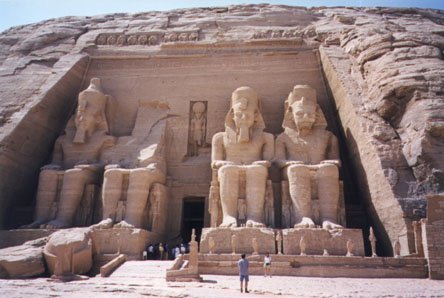
With the Nile cruise now over, we said goodbye to our cruise ship friends and took
a taxi to the Aswan airport. The two of us then took the 300 kilometer flight southward to
Abu Simbel, the site of one of the most impressive constructions by Egypt's greatest
pharaoh, Ramesses II. Deep in the heart of what used to be Nubia (now near the border of
Sudan), it is a site that not all tourists who visit Egypt take the time or the added
expense to visit. It was, however, a must-see for us, and while we sweated making our
tight airline connections going to and fro, we were so glad afterwards that we had been
there. (Speaking of sweating, the sun's heat in Aswan and Abu Simbel was much more
noticeable than it was in other parts of Egypt.) The massive seated statues of
Ramesses II were carved directly out of the side of the cliff, with the temple itself
carved even farther into the mountainside. When the new Aswan dam was constructed, this
site, like the temple at Philae, would have been lost under the waters of Lake Nasser. In
a race against the clock the two temples at Abu Simbel were cut out of their original
location, and placed at the current location above the lake's high water mark. You can
judge the height of the 65 foot high statues by the people standing near the darkened
temple entrance.
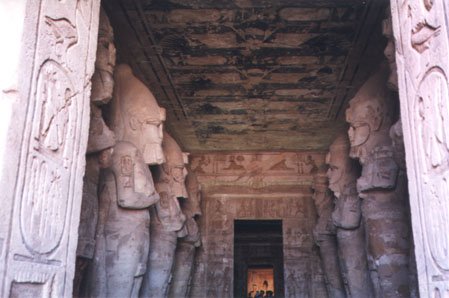
Between the two pairs of seated statues is a huge doorway that leads to the inner
temple. The inner hall has two rows of standing Osiris statues that are 33 feet tall, and
walls with very well done murals. Two times a year (on the solstices) the sun would
illuminate the temple interior all the way back to the farthest most room, which contains
four seated deity statues. When the temple was rebuilt at its new location, the engineers
did such a good job with the alignment that they were only off by a day on the semi-annual
event.
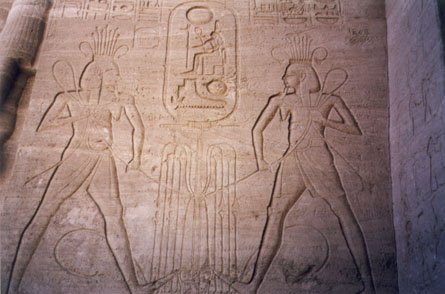
This is one of the wall murals at Abu Simbel that contains dual images of an
interesting figure. I forgot his name, but it is the personified deity of the Nile river.
It is shown as a male with some female characteristics (note the pendelous breast
appearing near the armpit). This was because the Nile was considered to be both male and
female.
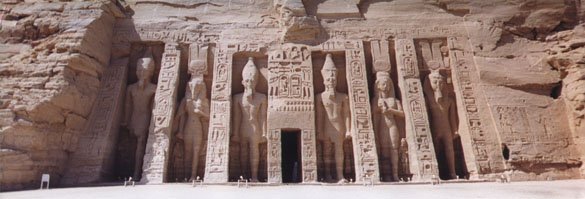
Part of the temple complex of Abu Simbel is the nearby temple dedicated to the
goddess Hathor that Ramesses II built for his wife Nefertari. It is unique in that some of
the huge statues in the front are of the queen Nefertari, and it was a rarity to have a
woman so honored. Like the temple of Ramesses II it was carved directly into the
mountainside, and had to be moved to its current location to escape the rising waters. My
panorama camera took the above photo.
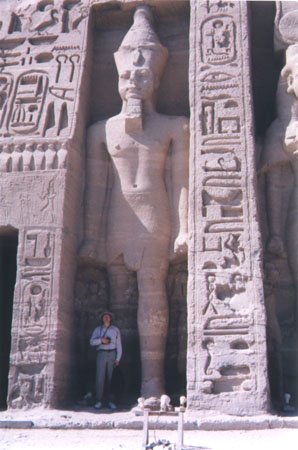
Here I am providing a sense of scale to one of the large statues outside of
Nefertari's temple.
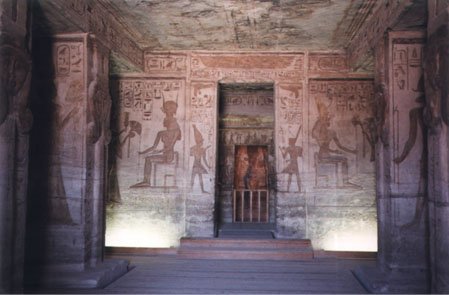
If I recall, this is a photo of the interior of Nefertari's temple. The wooden
floor and railing were obviously added for the tourist's sake. The artwork in this room
was excellent.